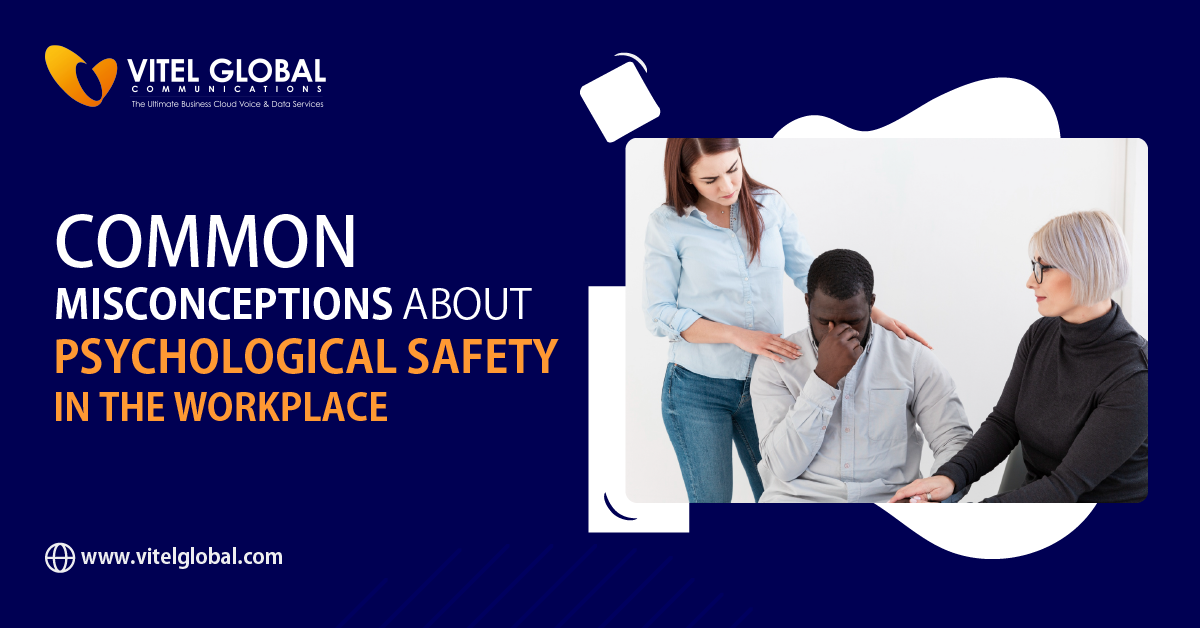4 Common Misconceptions about Psychological Safety in the Workplace

4 min read
What may not be as clear is that these two concepts are closely linked. It’s important to cultivate an environment where everyone feels free to take risks. It isn’t a frivolous perk: for employees to fully participate in their work, they need the knowledge. That they will not be punished if they’re wrong or make mistakes. It won’t impact the situation if employees don’t know what will happen when they speak up about problems like their workspace or process.
Explore the importance of psychological safety at work and its impact on employee well-being and productivity. Discover strategies to foster a supportive work environment.
When a group of people feels like they can rely on each other to support them in the face of difficulties. The members will be willing to take the risks necessary for creating growth within the organization. It isn’t about being “nice” or “holding hands” but about working together as a team around a common goal for everyone involved.
Safety in the Workplace can seem daunting, but it doesn’t have to be. In this blog post, we’ll explore the four most common misconceptions or myths about it and how to avoid them.
Psychological safety is one of the most important aspects of a healthy, productive work environment. But what is it? What are the misconceptions about this work-related concept?
To know more in detail about Psychological safety or to gain deeper insights into the topic, go ahead and download our curated E-Book entitled “How Do We Attain Psychological Safety In The Workplace”
Here Are 4 Common Misconceptions
- It’s only for new hires or students
- It takes a lot of time and money
- Bosses should initiate discussions about it
- you can have growth without safety
It’s Only For New Hires Or Students
It applies to all employees. Although it is most important during the initiation of a new hire or student. It remains important for years to come. It is so important that we need to create moments that allow us to respond as soon as hazards arise. Hazards might affect our well-being and the well-being of others in the Workplace.
For example, if an employee has been under much stress lately and their anxiety begins. To show (e.g., through an outburst or a major mistake), creating a safe space to respond to this situation is important.
It Takes A Lot Of Time And Money
The amount of time, energy, and resources required for it is greatly outweighed by the benefits. It can take a few minutes out of our day or just one simple conversation with a coworker. We can even ask ourselves questions that help us become more psychologically safe on the spot (more on that later).
Bosses Should Initiate Discussions
If your boss initiates conversations about safety all the time and you feel uncomfortable. It could be seen as selfish behavior and lead to isolation by your coworkers.
You Can Grow Without Safety
Balance the Growth by assurance; otherwise, employees must self-regulate their work and growth to avoid making mistakes.
It’s A Cookie-Cutter Solution
Many people will use the term “psychological safety” to refer to relationships where people feel safe within their group. Although this is helpful, we must remember that group members must cultivate and maintain it.
- Workers who feel safe in their jobs become complacent, lacking motivation to grow as individuals or develop new skills.
- Psychological safety fosters open dialogue and healthy disagreement, which leads to better decisions and a more productive workplace – leading to increased business success for companies that value this framework.
- Happiness increases performance because positivity increases engagement, but the relationship runs both ways; research shows that successful organizations make workers happier.
- It is an important quality for everyone, regardless of work conditions.
- Sharing emotions will lead to poorer performance: Sharing feelings and emotions can be a positive sign that employees are emotionally healthy and engaged in their work environment, which helps to increase morale and productivity and reduce stress and conflict within teams.
Most organizations look at psychological safety and think it is meant to be: a safe place where people are not afraid to expose themselves or their emotions. But that is only a small piece of the whole puzzle.
It refers to an environment where people feel comfortable admitting their errors, taking risks, questioning each other’s ideas, and feeling safe to speak when in discomfort or distress.
Safeness is also an environment where people feel comfortable expressing their feelings about each other’s actions and behaviors in a way that leads to growth for both parties involved. This type allows for true innovation, creativity, team building, having cloud HD meetings, and working together without fear of repercussions.
Allowing for protection allows employees to be open and authentic. But as any employee will tell you, there is a fine line between not feeling safe enough to admit mistakes and feeling uncomfortable enough to express their feelings about each other’s actions and behaviors. Many organizations still do not acknowledge that the fear of criticism or discomfort prevents employees from expressing themselves at work. Instead, they look at the concept of it as being nice.
But being nice does not necessarily make an employee vulnerable and human. And while everyone wants their coworkers to be happy, it is important to realize that happiness with coworkers does not necessarily mean you get along with them.
If protection is a priority, leaders in the organization must be willing to accept change, even if it makes them uncomfortable. The great thing about it is that everyone wins if you do it right. Allowing for security allows people to feel comfortable expressing themselves and admitting their errors, leading to growth at work and in life.
Conclusion
Use remote communication tools to communicate with your employees. The downside comes when the level of psychological safety is not managed properly. It’s important to remember that if employees are not self-aware enough to express their feelings about each other’s actions and behaviors, this can lead to resentment and anger.
Discover the common misconceptions about psychological safety & how to create a workplace that is truly safe & supportive.
Published: June 5th, 2023
Subscribe to Our Latest Updates
Get monthly product and feature updates, the latest industry news, and more!







